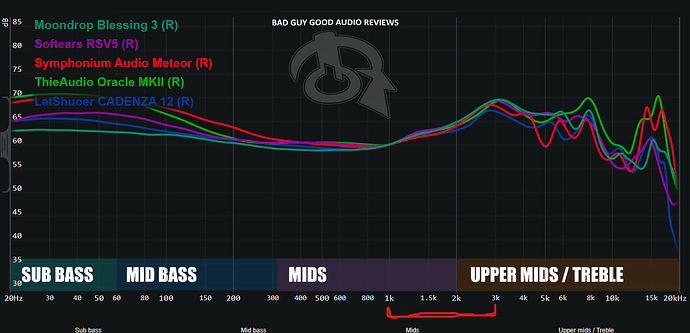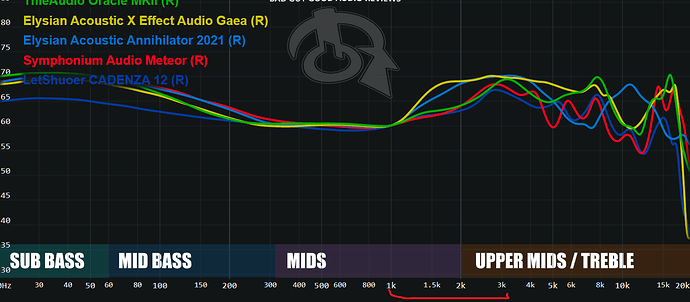I guess?
These arent EDM then? Since apperently it should sound like ear rape on SSR according to you.
I guess?
These arent EDM then? Since apperently it should sound like ear rape on SSR according to you.
You guys need to consider that everyone has a different HRTF.
Personally the SSR looks like is way above my pinna gain tolerance.
And no, the treble doesnt look dark imo. Its boosted because the bass shelf rises pretty early and is mid-bass focused, so if it didnt have that treble gain, it is likely to sound quite bloated.
so i got some free time and decided to actually try to see how ssr will likely sound like. i got the songs you posted and tested it for about an hour comparing it with other sound signatures, and oh boy i was wrong before to be honest.
so here is the graph
and here are the songs that you posted
the results were interesting, the boost in the whole midrange area kills the whole clarity of the sound, so as @Rikudou_Goku mentioned above, the only way to get out of the mud is to boost the upper mids and treble but that just adds to the problem of a sound that is closed in, so they could boost after 8k to maybe help with the dynamics and resolution but they didn’t like most single dd iems. this makes the sound unclear, lacking in any excitement yet the the upper midrange and lower treble are still boosted without the air to back it up so it gives the unrealistic plasticky feel on top of the muddy midrange, the total opposite of what i assumed.
tldr, a sound thats not open feeling at all, lacks dynamics due to the boosed midrange and subbass missing. it sounds heady due to the excess ear gain and lower treble area without having actual upper treble energy from 8k to 15k to save slightly it from that closed in feeling in your head and giving it actual resolution.
I still feel like soundstage is more than just the frequency response or at least I personally don’t know how to specifically increase it with EQ. And the differences in soundstage between IEMs are very stark to me. Maybe it’s a function of driver distance and angle like with headphones and how it intereacts with the ear canal, no idea. Or maybe the frequencies that give the spatial qualities are high enough that their measurements are unreliable.
But yeah I don’t have much faith in immeasurable “technicalities”. Either it shows up on graphs(not just FR but also distortion and likely group delay) or you’re imagining it. It’s confounded by the fact that until recently competently tuned IEMs weren’t all that common. But hey, human mind is powerful, if spending $2000 on a pair of IEMs makes you feel that they sound better, they WILL sound better to you.
Interesting, thank you for informing that Oracle cant perform well when eqed to SSR I think?
@LearningToSmile Who knows? Personally Ive given up on trying to find logic in the FR means everything and apple dongle is endgame since transient responce is more important and can only be modified to a minor extent with dynamic eq along with driver characteristics.
If you go strictly by FR to evulate my preferences which my endgames being TRI starshine and Fiio FD7 it makes sense that true harman tuned garabge like blessing 2 dusk and IER-Z1R sounds like absolute trash to me but I was surprised then when Effect Gaea sounded so good even though tonally it has the same lower mids dip.
flat midrange, bass tuck and specially depressed 1k to 3k area makes the sound appear wider and open inside your head. more eargain and upper treble makes the sound appear taller and massive.

unlike these, that boost these area to get sharper note attack, more pronounced detail for the sake of “illusion” of sepperation

but anyways iems have no real soundstage. none
for an actual soundstage you need 2 or more speakers 1+ meters apart directed to your ears or maximum 15 degrees off axis for some coaxial speakers to get actual soundstage and center imaging. in iem each ear hear separately but in speakers both ears hear the opposite speaker like how both eyes work together to focus, it gives depth and actual stage to the sound unlike iems.
That’s really not my experience. Particularly the bass tuck absolutely has nothing to do with soundstage.
Anyway, of course IEMs and headphones will never be speakers so they’ll never sound the same, but IEMs absolutely can have significant difference in soundstage between different IEMs - for me, in an IEM with what I consider good soundstage hard panned left/right sounds sound like they’re left/right to me outside of my head, while with a bad soundstage everything sounds like it’s coming from inside of my skull. And it’s not really some subtle effect either.
i EQed the buds not the oracles, but doesn’t matter since both sound pretty close.
this is how a pair of well tuned reference studio monitors sound like in a treated room
neumann kh420 about 10000$ a pair
harman tuned iems are neutral tuned iems, if you flatten their fr to the diffuse field target( fr of ears in a treated room, how do we hear in a treated room) you get a tilted downslope line just like those monitors.
it seems like you will dislike uncolored sounds if you found them trash sounding.
That is not true at all. Harmant target is a target found after they researched a few people´s preferrence after they used EQ on a transducer (HD800 iirc). Nothing to do with “neutral”.
so is it a coincidence that when you flatten anything that has been tuned to harman to the average ear fr in a nearfield or far field position(diffuse field), you get results of a neutrally sounding speakers in a room?
Coincidence or not, it doesnt change wha the purpose of harman target is…
and what it is?